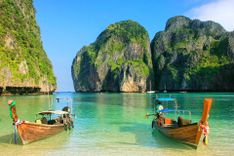Mangrove tours
A boat trip through the eerily scenic mangrove-lined channels of the Krabi estuary is a fun way to gain a different perspective on the area. As well as a close-up view of the weird creatures that inhabit the swamps, you’ll get to visit a riverside cave or two. Tours are best organized directly with the longtail boatmen who hang around Krabi’s two piers and the surrounding streets, but can also be arranged through most tour agents.
The estuary’s most famous features are the twin limestone outcrops known as Khao Kanab Nam, which rise a hundred metres above the water from opposite sides of the Krabi River near the Maritime Park and Spa Resort and are so distinctive that they’ve become the symbol of Krabi. One of the twin karsts hides caves, which can be explored – many skeletons have been found here over the centuries, thought to be those of immigrants who got stranded by a flood before reaching the mainland. You can also choose to visit the Muslim island of Ko Klang.
Life in a mangrove swamp
Mangrove swamps are at their creepiest at low tide, when their aerial roots are fully exposed to form gnarled and knotted archways above the muddy banks. Not only are these roots essential parts of the tree’s breathing apparatus, they also reclaim land for future mangroves, trapping and accumulating water-borne debris into which the metre-long mangrove seedlings can fall. In this way, mangrove swamps also fulfil a vital ecological function: stabilizing shifting mud and protecting coastlines from erosion and the impact of tropical storms.
Mangrove swamp mud harbours some interesting creatures too, like the instantly recognizable fiddler crab, named after the male’s single outsized reddish claw, which it brandishes for communication and defence purposes; the claw is so powerful it could open a can of baked beans. If you keep your eyes peeled you should be able to make out a few mudskippers. These specially adapted fish can absorb atmospheric oxygen through their skins as long as they keep their outsides damp, which is why they spend so much time slithering around in the sludge; they move in tiny hops by flicking their tails, aided by their extra-strong pectoral fins. You might well also come across kingfishers and white-bellied sea eagles, or even a crab-eating macaque.
Though the Krabi mangroves have not escaped the environmentally damaging attentions of invasive industry, or the cutting down of the bigger trees to make commercial charcoal, around fifteen percent of the Andaman coastline is still fringed with mangrove forest, the healthiest concentration of this rich, complex ecosystem in Thailand.





